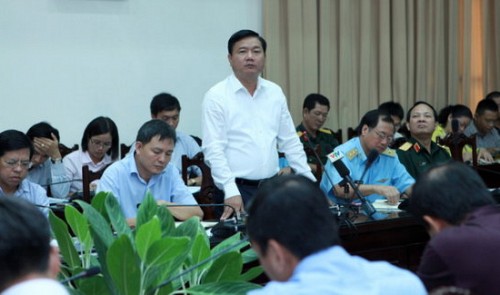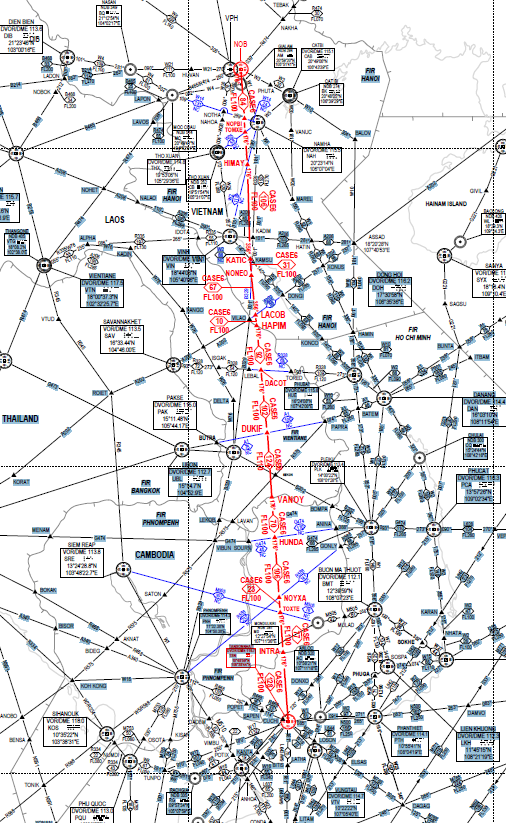Cross-Indochina route not a matter of right or wrong: Vietnam minister

The Ministry of Transport has assigned the Civil Aviation Authority of Vietnam (CAAV) and two carriers, Vietnam Airlines and VietJet Air, to test what is known as the ‘golden air route’ between Hanoi and Ho Chi Minh City through the airspace of Laos and Cambodia.
The two carriers completed flight simulations on the route last week, and the CAAV also finished testing earlier this week.
At the Wednesday meeting to report its results, the CAAV said a simulated flight on the cross-Indochina route was 85km shorter than the current one, and helped save five minutes of flying time, as well as 190kg of fuel.
The results are similar to those achieved by national flag carrier Vietnam Airlines.
Minister of Transport Thang said he could not believe that the proposed route shortened the travel time by only five minutes, though he admitted that “a minute saved is precious enough.”
The minister asked the CAAV to continue cooperating with relevant agencies in studying the proposed route to implement it in an efficient way.
Thang also said he will work with his Lao and Cambodian counterparts on the issue.
He emphasized that the study of the cross-Indochina air route is not meant to prove that some individuals are right, while others are wrong.
“Anything that is beneficial and economical for airlines and passengers must be done,” he said.
The controversial ‘golden air route’ was first proposed by a retired pilot in Ho Chi Minh City in 2009, and again by an aviation expert in 2012.
The idea received strong opposition from industry insiders and experts, while enjoying support from the Vietnamese transport ministry and the CAAV.
The transport ministry said the route had previously been discussed among the Indochinese countries back in the 1980s.
Minister Thang requested that the CAAV report a final conclusion on the route by the end of October.
Five minutes, 190kg of fuel
CAAV chief Lai Xuan Thanh said the provisional air route faces three challenges.
Vietnam first has to call on Lao aviation authorities to allow flights to reach flight level (FL) 350, or 10.6km, to save more fuel. The current allowed FLs in Laos range from 240 to 280 (7.3-8.55km), Thanh said.
Vietnam also has to reorganize its airspace so that planes plying the proposed route will not have to avoid currently restricted zones.
“Finally, we have to negotiate with Laos and Cambodia to reduce the fees for using their airspace,” he said.
Dinh Viet Thang, general director of the Vietnam Air Traffic Management Corporation, said geometrically speaking, the straight route between Hanoi and Ho Chi Minh City is much shorter than the current one.
“But a flight path depends on the takeoff and landing methods at each airport, as well as the altitude changing during flight, so the distance is only shortened by 85km,” he said.
Thang added that as the air traffic control ability of Laos is limited, Vietnam should only open a one-way route from Ho Chi Minh City to Hanoi, crossing Lao and Cambodian airspace.
“And the Hanoi-Ho Chi Minh City service will use the current air route,” he said.
Vietnamese airlines currently fly between Hanoi and Ho Chi Minh City on a ‘roundabout’ route that spans a sea area between the capital and Da Nang in the central region, and crosses over the mainland between Da Nang and the southern city.

Map of the straight air route between Hanoi and Ho Chi Minh City. Source: CAAV
What the stars mean:
★ Poor ★ ★ Promising ★★★ Good ★★★★ Very good ★★★★★ Exceptional
Latest News
More News
- Businesses ramp up production as year-end orders surge (December 30, 2025 | 10:05)
- Vietjet chairwoman awarded Labour Hero title (December 29, 2025 | 13:06)
- How to unlock ESG value through green innovation (December 29, 2025 | 10:03)
- AI reshapes media and advertising industry (December 29, 2025 | 08:33)
- FPT and GELEX sign deal to develop blockchain tech for global markets (December 29, 2025 | 08:29)
- Vietnam’s GDP forecast to grow by 9 per cent in 2026 (December 29, 2025 | 08:29)
- Women entrepreneurs are key to Vietnam’s economic growth (December 29, 2025 | 08:00)
- Vietnam's top 500 value-creating enterprises announced (December 27, 2025 | 08:00)
- The PAN Group shaping a better future with ESG strategy (December 26, 2025 | 09:00)
- Masan Consumer officially lists on HSX, marking the next phase of value creation (December 25, 2025 | 13:20)

















 Mobile Version
Mobile Version